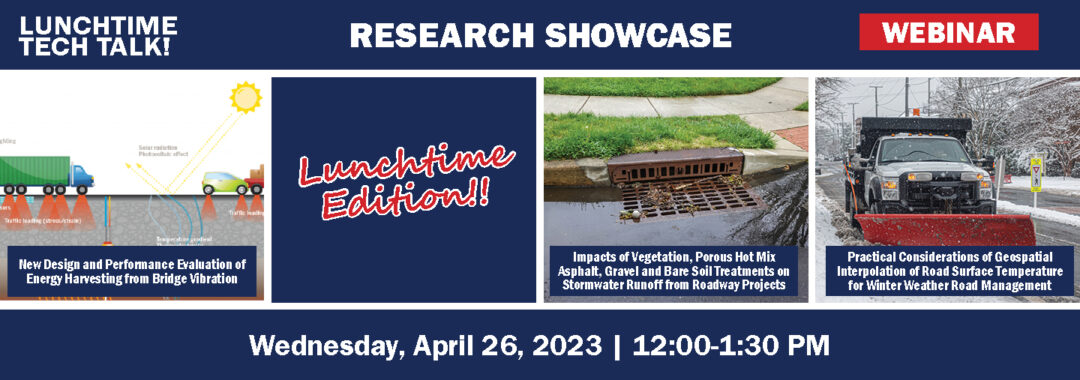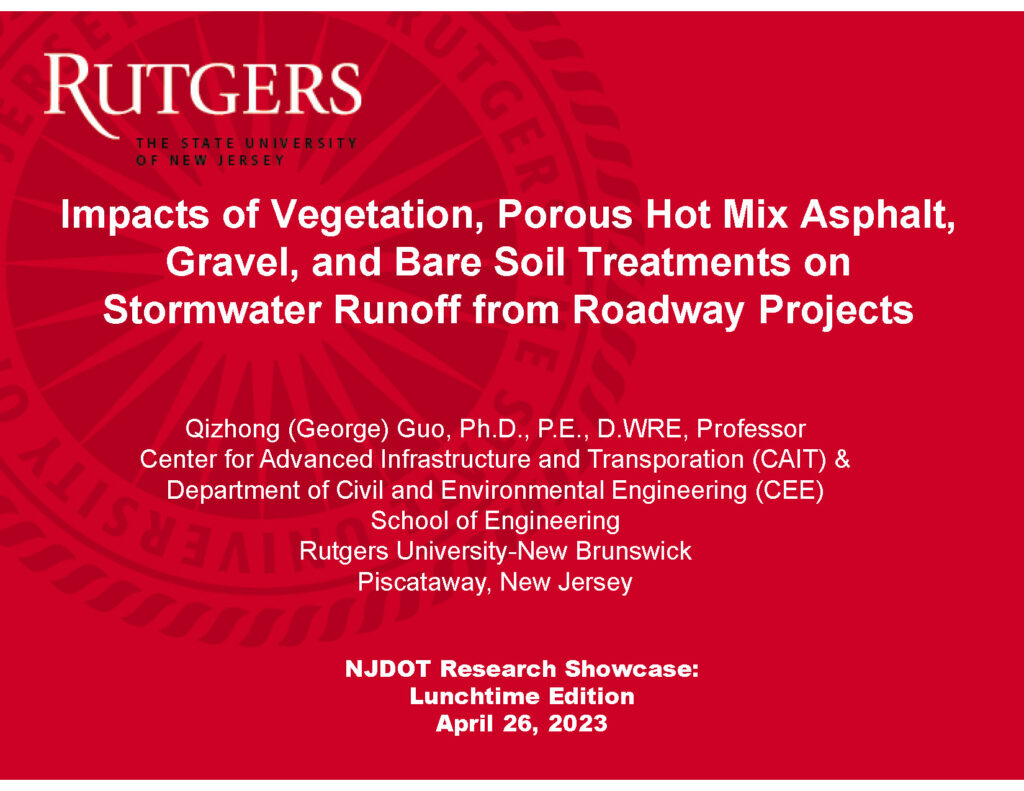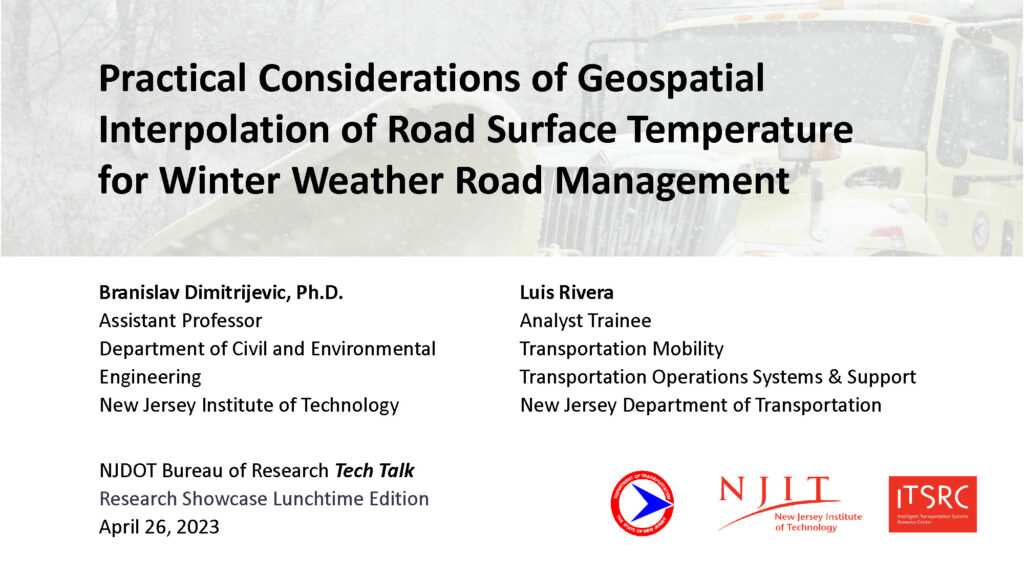On April 26, 2023, the NJDOT Bureau of Research hosted a Lunchtime Tech Talk! webinar, “Research Showcase: Lunchtime Edition!”. The event featured three important research studies that NJDOT was not able to include in the NJDOT Research Showcase virtual event held last October. The Showcase serves as an opportunity for the New Jersey transportation community to learn about the broad scope of academic research initiatives underway in New Jersey.
The three research studies explored issues at the intersection of transportation and the environment and the advancement of sustainable transportation infrastructure. The presenters, in turn, shared their research on the design and performance evaluation results of harvesting energy through transportation infrastructure; the properties of various materials used in roadway design treatments to effectively quantify and mitigate stormwater impacts of roadway projects; and analytical considerations inherent in estimating road surface temperatures to inform the development of a winter weather road management tool for NJDOT. After each presentation, webinar participants had an opportunity to pose questions of the presenter.
Presentation #1 – New Design and Performance Evaluation of Energy Harvesting from Bridge Vibration by Hao Wang, Associate Professor, Civil and Environmental Engineering, Rutgers Center for Advanced Infrastructure and Transportation (CAIT)
Dr. Wang noted that energy harvesting converts waste energy into usable energy that is clean and renewable for various transportation applications. Energy harvesting projects can be large scale (solar or wind energy solutions) or micro-scale (providing power for lighting, self-powered sensor devices, and wireless data transfer).
In this project, the large scale application considered the use of photovoltaic noise barriers (PVNBs) which integrate solar panels with noise barriers to harvest solar energy. His research developed energy estimation models at the project- and state-level for a prototypical design installation of noise barriers.
In his presentation, Dr. Wang focused on the micro-scale application that employed piezoelectric sensors on bridge structures. He noted that piezoelectric energy harvesting can be achieved by compression or vibration. He explained that traffic and winds cause roadway bridges to vibrate. This movement subjects the piezoelectric sensors to mechanical stresses or changes in geometric dimensions which create an electric charge.
Piezoelectric energy harvesting is affected by the material, geometry design of the transducer, and external loading. Instead of embedding sensors in pavements, the researchers sought to attach the sensors to the bridge structure imposing less impact on the host structure and increasing the ease of installation. They developed and evaluated new designs of piezoelectric cantilevers to create a range of resonant frequency to match with bridge vibration modes.
Multiple degree-of-freedom (DOF) cantilever designs were tested in the laboratory, and in full-scale tests. The goal was to customize the design to maximize power outputs resulting from bridge vibrations. Multiple cantilever design options were examined with adjustable masses. Simulation models were developed for estimating energy harvesting performance and to facilitate the optimization of mass combinations through quantitative models.
The researchers used finite element models to simulate the effect, and assessed the model in the laboratory to manage the voltage output of various designs. Bridges have multiple vibration frequencies under different vibration modes, on the bridge structure and the span. A full-scale bridge test was conducted using the Rutgers-CAIT Bridge Evaluation and Accelerated Structural Testing lab (BEAST) to give sample voltage outputs from cantilevers.
Future research will be needed to explore the effect of loading speed that takes into consideration the variable speeds on a bridge something that was not captured in the laboratory testing.
Findings of the research included: multiple degree of freedom (DOF) cantilevers can generate considerable energy when resonant frequencies match vibrational frequencies of the bridge structure; finite element modeling can predict resonant frequencies of multiple-DOF cantilevers as validated by experiments and ensures that numerical models can be used to explain the relationship between resonant frequency and mass combination for optimized design; and the proposed cantilever designs and optimization approach can be used for piezoelectric energy harvesting considering a variety of vibration features from bridges under different external conditions.
Dr. Wang responded to questions following his presentation:
Q. How far below the asphalt are the sensors placed and how often do they need to be replaced?
A. For this project, the installation in this phase used a magnetic fixture to attach the cantilever to the girder. The installation procedure was easy for this phase. For a field installation, we will need to consider more thoroughly the mount and durability but did not need to address this during this phase and we do not have real-world data now to share about that.
Q. Would the vibrations be amplified with the cables?
A. The cables on the real bridge – if we attached to the cable the vibrations would be less, which is why we attached them to the girder.
Presentation #2 – Impacts of Vegetation, Porous Hot Mix Asphalt, Gravel and Bare Soil Treatments on Stormwater Runoff from Roadway Projects by Qizhong (George) Guo, Professor, Civil and Environmental Engineering, Rutgers Center for Advanced Infrastructure and Transportation
Dr. Guo described the effect of increased impervious coverage in urban locations that leads to increased surface water runoff. Transportation agencies are required to assess and mitigate the stormwater runoff impacts of roadway projects. The project explored the effect on runoff of use of gravel, vegetation, porous Hot Mix Asphalt (HMA), and bare soil. Areas where these materials would be used include the roadway right-of-way, medians, and beneath guiderails.
Variables explored in lab testing included subsoil hydraulic conductivity, rainfall intensity and rainfall duration. The researchers used the Curve Number (CN) method for estimating direct runoff from rainstorms. Lab testing involved a column of soil with little lateral flow and limited depth to the level representing the water table. To apply lab findings to field conditions, the regression equation of Curve Number versus the infiltration rate obtained from the laboratory measurements can be applied after replacing the laboratory-measured infiltration rate with the field-measured subsoil hydraulic conductivity or assigned hydrologic soil groups.
This research resulted in Curve Numbers for bare soil and vegetation similar to the established CNs for dirt (including right-of-way) and open space (lawns, fair condition). The estimated CNs for gravel were significantly smaller than the established CNs for gravel (including right-of-way). The research resulted in CNs for porous HMA but no comparison can be made as there is no established CN for this material. The project could help NJDOT in seeking approval of the Curve Numbers for gravel and porous HMA from regulatory agencies. In addition, the study affirmed the use of pervious surfaces and the effectiveness of stormwater runoff reduction to restore natural hydrology.
Following the presentation, Dr. Guo responded to questions asked through the chat feature:
Q. What are preventative measures to avoid porous HMA clogging?
A. Sediment source control is needed to prevent dirt and dust from entering the porous HMA. If the area around the pavement is subject to erosion, runoff carries this dirt or sand into the material. If the material becomes clogged, a vacuum is needed to clean it.
Q. Can we disperse runoff in roadway drainage systems as opposed to collection?
A. There are several ways to disperse runoff, such as by the use of rain gardens, a horizontal spreader, or use of a stone/gravel strip to spread the runoff.
Some questions were submitted in the Chat and, due to time constraints, were answered by Dr. Guo after the Tech Talk.
Q. We recently had a project meeting during concept development where we suggested porous asphalt for guide rail base. Another team mentioned they would prefer we not use PHMA due to it clogging over time and basically becoming HMA. What research has been done on PHMA effectiveness over time, and what can be done to remedy reduced flow (if it does occur)?
A: The clogging of porous hot mix asphalt (PHMA) and other porous pavement varieties is undeniably a significant and pressing issue. Our study for NJDOT did not tackle the problem of clogging, but other researchers have conducted relevant investigations, and more targeted research is anticipated. The most effective method to reduce clogging is by preventing excessive coarse sediment from entering PHMA and other porous pavements. Special care should be taken to maintain the surrounding landscape in order to mitigate soil erosion, and not to apply sand to any of the road surfaces for snow abatement. Alternatively, sediment in the runoff can be captured or filtered using a swale or gravel strip before it enters the PHMA or other porous pavement areas. Implementing a proactive inspection and monitoring system for clogging is also essential.
In cases where PHMA or other porous pavements become clogged, a vacuum street sweeper or regenerative air sweeper can be employed to dislodge and remove the solid materials. However, traditional mechanical sweepers should be avoided, as they may cause the solids to break down or force particulates deeper into the porous spaces, exacerbating the clogging issue in porous pavements.
Q. Did you use the same course stone mix in the NJDOT specs for the course stone non-vegetative surface. I assume you are calling this gravel.
A: Yes, the NJDOT construction specifications were adhered to in the design of the laboratory setup for all four land treatment types: gravel, porous hot mix asphalt, vegetation, and bare soil. These specifications can be found in the “Roadway Design Manual (2015)”, “Standard Construction Details (2016)”, and “Standard Specifications for Road and Bridge Constructions (2019)”. Comprehensive details are provided in Table 13 in Appendix A of our Final Report for the research project (FHWA-NJ-2023-004).
Q. What compaction did you use for the porous HMA? We usually use only a small portable tamper machine in the field with about 2 passes.
A. In our laboratory, a gyratory compactor was employed for the compaction of the porous HMA samples tested. Two relevant sentences in our Final Report for the research project (FHWA-NJ-2023-004) state: “For the porous asphalt land treatment, cylindrical porous Hot Mix Asphalt (HMA) gyratory samples with a diameter of 6 in and a depth of 4 in were manufactured at Rutgers CAIT Asphalt Pavement Lab. The mix design utilized to manufacture the HMA met the requirements of the Open-graded Friction Course in the Updated Standard Specifications for Road and Bridge Construction (2007).”
Q: Can this report be used to get acceptance of porous HMA by DEP?
A: Yes, although further dialogue with NJDEP, NRCS, and other relevant agencies or organizations may be necessary for the ultimate acceptance.
Q: NJDOT Materials lab did a study of various ages of porous HMA in the field and found out that it did not clog over an 8 year period. It appeared to be self-cleaning.
A: I appreciate the information you provided. The likelihood of porous HMA clogging is closely related to the volume and size of solids, sediment, or particulates entering it. A minimal amount of fine particulates is unlikely to cause serious or rapid clogging issues in porous HMA. To my knowledge, there is no “self-cleaning” mechanism inherent in porous HMA.
Q: What about the contamination in runoff water which will penetrate in subsoil?
A: Contaminants in runoff water should not be allowed to infiltrate the subsoil. Highly contaminated runoff must not directly enter land treatments (LTs), green stormwater infrastructure (GSI), stormwater Best Management Practices (BMPs), or stormwater control measures (SCMs). Instead, these systems will treat mildly contaminated runoff as it passes through them. Consequently, the runoff water will achieve a relatively high level of purity before it infiltrates the subsoil.
Presentation #3 – Practical Considerations of Geospatial Interpolation of Road Surface Temperature for Winter Weather Road Management by Branislav Dimitrijevic, Assistant Professor, Civil and Environmental Engineering, New Jersey Institute of Technology (NJIT) and Luis Rivera, Analyst Trainee, NJDOT Transportation Mobility, Transportation Operations Systems & Support
Mr. Rivera provided background on NJDOT’s Weather Savvy Road System that addresses the need for proactive winter road maintenance and the wide variation in road conditions throughout the state. There are only 48 stationary Road Weather Information Systems (RWIS) stations across the state in areas that are deemed essential. They provide information on road conditions (wet or dry), and road temperature. The Weather Savvy Road System integrates stationary RWIS and mobile RWIS (MRWIS) to track road conditions in real time, provide data visualization to operators to inform decision-making, and assist in planning road management.
In 2017, NJDOT received a USDOT Accelerated Innovation Deployment grant for implementation of FHWA’s Every Day Counts Round 4 Weather Savvy Roads Integrating Mobile Observations (IMO) innovation. The agency deployed Internet of Things (IoT) and Connected Vehicle technology to improve road weather management. NJDOT installed sensors and dash cameras on 24 fleet vehicles to pick up air temperatures, road temperatures, surface condition, and road grip, and portable PC equipment to analyze and report this information to improve safety for the traveling public and inform decision-making. Road surface temperature is the most indicative measure of road condition.
Dr. Dimitrijevic discussed research undertaken to gather road surface temperatures using Kriging, a geospatial interpolation model. The goal was to discover a way to extrapolate the information collected from the sensors to provide estimated road surface temperatures across the entire road network within NJDOT’s jurisdiction.
The researchers collected data from RWIS/MRWIS and other data available, including land coverage, elevation, etc., that can affect road surface temperatures (RST). They sought to use a Kriging Interpolation and Machine Learning Model to give estimated RSTs over the network to inform planning and evaluation of winter road maintenance efforts. Variability in RST across the analysis region is a big factor. Researchers needed to find a function that fit the variability between the data points, and use that to estimate the parameter value at any particular point.
Dr. Dimitrijevic discussed the differences between three Kriging methods: Ordinary Kriging and Universal Kriging, the simplest and fastest to calculate; regression Kriging which uses additional factors, besides distance, that will affect RST; and Empirical Bayesian Kriging that uses Bayesian inference to calculate parameters, but also calculates the probability of making an error.
All three Kriging methods assume that for any correlation between a given parameter that you are trying to estimate in a given area, there is a relationship between the values of that parameter at different points that depends on the actual location of the points, or distance between points. The method uses the known value of surrounding parameter points, for example, the road surface temperature at these points, and measures the distance between these points of known parameter value to estimate the parameter (RST) at the unknown point. Kriging assumes a statistical relationship involving the distance between RWIS stations.
Researchers conducted case studies using RST interpolation of stationary RWIS data by driving between RWIS locations, and then expanded the RWIS coverage of mobile sensors during a winter storm event. They found the best results came from combining RWIS and mobile RWIS data. They found Regression Kriging to be helpful for including other factors (the most statistically significant being vegetation type, land cover type, distance to water, and elevation). Increasing the mobile RWIS records reduced the error level, and this finding resulted in a recommendation to increase the number of mobile sensors on NJDOT’s fleet.
Kriging was effective in capturing the spatial variation in the dataset. An error of one degree Fahrenheit still needs to be addressed. The researchers continue to look into solutions in ongoing research which will explore additional interpolation methods, integration of short-term past predictions, and a bi-level interpolation using stationary RWIS data at a regional scale and the mobile RWIS data to make adjustments to the local scale.
The model that performed best was implemented in a web-based map tool that gathers data in real time and refreshes the estimated road surface temperature every 10-15 minutes, providing a map and the ability to download data. When complete, this tool will become part of the toolbox for Operations, Maintenance and Mobility division.
Dr. Dimitrijevic answered questions following his presentation:
Q. How is the dew point and frost point measured by the sensor?
A. Dew point is not measured; there are statistical models that calculate readings of air temperature, air humidity and pressure to determine dew point or frost point. Dew point and frost point are the same thing. The term used depends on the temperature.
Q. What other interpolation models, besides Kriging, will you be looking at?
A. We are looking at a combination of machine learning and geo-statistical modeling. There is also bi-level modeling that uses one method to regress the regional scale estimate, and another to use the localized readings to adjust the estimates for a local roadway. These methods require more computation time, but we are looking for models that can calculate in real time for tactical management purposes.
A recording of the webinar is available here.
Resources
Cowan, S., Catlett., S. Ahmed, R., Murphy., T., Dimitrijevic, B., Besenski, D., Spasovic, L., and Zhao, L. (2022). Weather-Savvy Roads Pilot Program, Final Report. Retrieved from: https://www.njdottechtransfer.net/wp-content/uploads/2022/11/WeatherSavvy_FinalReport_20220613.pdf
Qizhong (George) Guo, Robert Miskewitz, John Hencken, Lin Zheng, Diego Meneses, (2023). Evaluation of Coefficient Related to Runoff from Roadway Projects [Final Report]. Retrieved from: https://www.njdottechtransfer.net/wp-content/uploads/2023/05/FHWA-NJ-2023-004.pdf
Wang, H., Guo, L., and Soares, L. (2023). Energy Harvesting on New Jersey Roadways [Final Report]. New Jersey Department of Transportation Bureau of Research. Retrieved from: https://www.njdottechtransfer.net/wp-content/uploads/2023/05/FHWA-NJ2023-001.pdf
Wang, H., Guo, L., and Soares, L. (2023). Energy Harvesting on New Jersey Roadways [Technical Brief]. New Jersey Department of Transportation Bureau of Research. Retrieved from: https://www.njdottechtransfer.net/wp-content/uploads/2023/05/FHWA-NJ2023-001_TB.pdf



